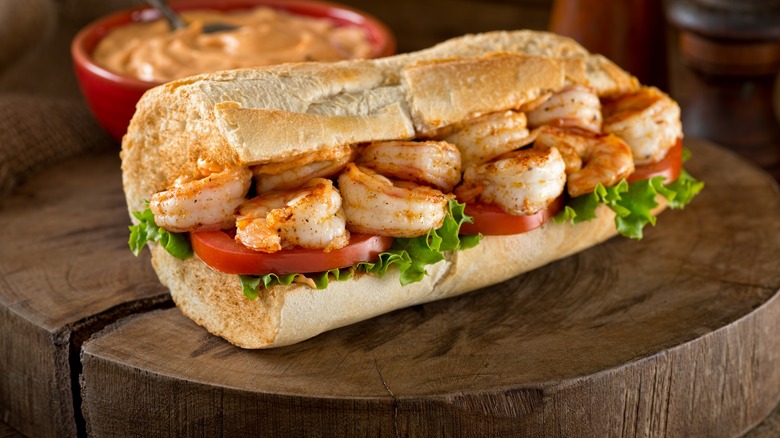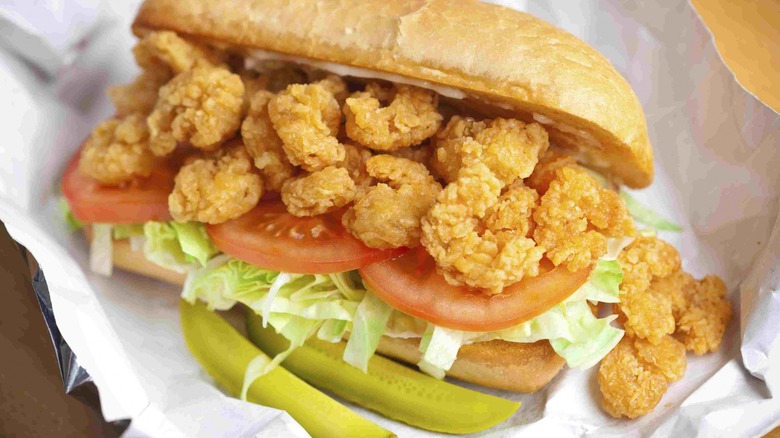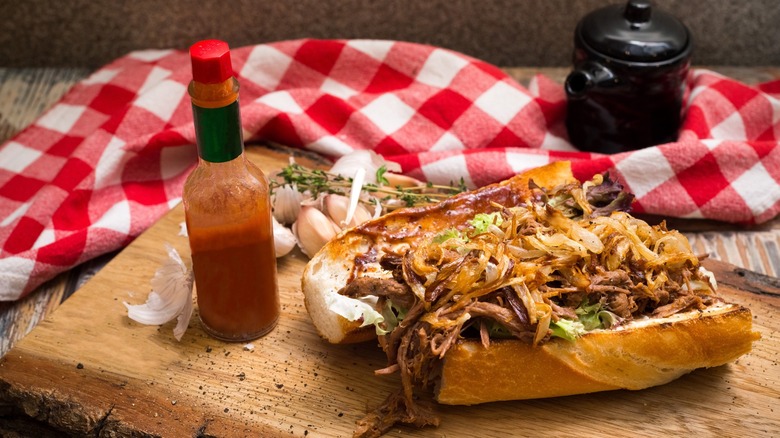The Absolute Best Bread For Saucy Po'boy Sandwiches
The po'boy sandwich is one of the quintessential dishes of New Orleans, encapsulating the city's cultural intersection between its French roots and location in America's Deep South. Stuffed to the brim with fried shrimp or other seafood or meat fillings, and often topped with a heavy mayo-based Cajun-style sauce, po'boys require a hefty bread to hold everything together. At the same time, the bread selected for the fried, saucy goodness that is a po'boy must be able to soak up all the juices that emanate from within. That's why po'boys usually use a unique type of baguette that's slightly different from the traditional French style.
This local creation, known as New Orleans-style French bread, came about as a result of wheat scarcity in colonial Louisiana. The crop couldn't grow in Louisiana's humid, swampy environment, and imported wheat often arrived to the city moldy or infected with insects. As a workaround, local bakers used less flour and more water, which resulted in a unique style of bread that resembled a baguette but was lighter and airier than its European counterpart.
The perfect po'boy
For a dish so packed with ingredients, there's an argument to be made that the most essential part of a po'boy is the bread. Although fried shrimp is often the default setting for the sandwich, fillings run the gamut: Popular alternatives include oysters, hot sausages, catfish, and roast beef. A Cajun aioli-style dressing called remoulade sauce complements seafood beautifully, while savory gravy is often slathered on top of beefier options. Despite these variations, it's still the New Orleans-style French bread that holds everything together. As Justin Kennedy, the general manager and head chef of NOLA po'boy spot Parkway Bakery & Tavern, explained to BBC, "The real clue to what makes a po' boy is the bread. It has a uniqueness to it that you'd be hard pressed to find anywhere else."
Kennedy went on to describe the loaf as "flaky and crusty on the outside and really soft and nearly hollow on the inside," perfect for soaking up all the inevitable (and delicious) run-off. The bread's lack of density makes it remarkably light, and its nooks and crannies on the inside accentuate its airiness. If a po'boy ever feels heavy, it should be the meat, not the bread, that's contributing to the weight.
The bakers behind the bread
New Orleans-style French bread was originally born out of a dearth of traditional ingredients, but it has become a coveted baking method unique to the city. While the po'boy sandwich dates back to 1929 during the city's streetcar driver strikes, the origins of the po'boy's French bread go back even further. Many believe the po'boy was invented by brothers Benny and Clovis Martin, who sought out meals to feed to the striking "po' boys." They turned to the John Gendusa Bakery, which had opened seven years prior in 1922, to supply the now-iconic sandwich bread.
Sadly, the po'boy bread is now something of an endangered species, as only two institutions — the Gendusa and the German-founded bakery, the Leidenheimer — still make the loaf in the traditional style. Alois J. Bakery, the third member of what used to be a holy trinity of suppliers, ceased operations in 2018. Of course, imitations abound, and it's still possible to find a loaf that may feel similar to the classic New Orleans French bread. Most notably and fascinatingly, the Vietnamese bánh mì bread is made in the style of the po'boy's New Orleans-style French bread. Alas, while a true po'boy made with its traditional bread is harder to come by these days, it's not time to bid adieu just yet.



